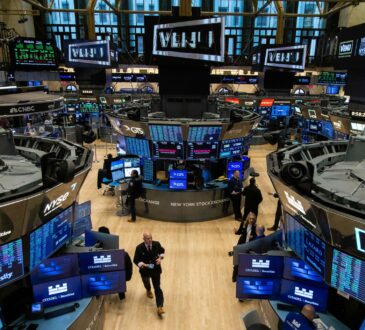
The stock market is like that classic Sesame Street song. One of these things is not like the others. The
and
have been hitting new records this week. But the
has not.
The Dow reached a peak above 40,000, closing above that milestone on May 17. But since then, the index of 30 industrials have slid about 3.5%.
It’s been a broad-based decline, with 19 Dow components falling so far this month. So why has the Dow faltered even as the other major market indexes keep powering higher? The disconnect is almost amusing to those not invested in funds pegged to the Dow.
Chalk it up to both a combination of the Dow’s unique price-weighted approach—both the S&P 500 and Nasdaq are market-cap weighted. There’s also the fact the Dow’s heavily laden with rate-sensitive financial stocks, which have tumbled along with long-term bond yields.
stock is the biggest laggard in the Dow in June, down more than 6%. Shares of Travelers and
are the fifth- and sixth-worst performers.
stock has slid this month as well.
Advertisement – Scroll to Continue
Financials aren’t the only struggling Dow stocks, though. Other companies in more value-oriented, cyclical sectors have been hit, too.
is the second-worst Dow stock in June. Shares of
Disney
,
and
are also sandbagging the index.
The big winners in the Dow on the other hand are largely in tech. Shares of
Apple
,
and
are the top three performers. But these are also the big market-cap-weighted stocks lifting the S&P 500 and Nasdaq…and they don’t have as much impact on the daily swings of the Dow, which is exposed to the stock prices of the individual components.
Sure, Microsoft has the third largest price weighting. But Apple and Amazon are only the 11th and 15th largest Dow components respectively.
That means that their big gains this month aren’t enough to offset the fact that nearly two-thirds of the Dow components have fallen in June, including heavily weighted Dow stocks Goldman, Caterpillar,
Amgen
,
and
Advertisement – Scroll to Continue
“There has been a narrow surge,” said Phil Orlando, chief equity strategist with
in an interview with Barron’s. He added that the market “may be reaching a point where the rally should broaden out” but conceded that many large-cap-value stocks “have been left for dead.”
This trend could continue. Large-cap growth is still the area of the market that many investors seem to love the most.
Sinead Colton Grant, chief investment officer at BNY Wealth, formerly known as BNY Mellon Wealth, told Barron’s that she favors large-cap-growth sectors such as technology and communications services because they are continuing to innovate, have low levels of debt and generate significant cash flow.
Advertisement – Scroll to Continue
That should insulate them from any concerns about the Fed possibly leaving interest rates unchanged until December…if not longer. Colton Grant added that reasonable valuations and strong earnings growth should lead to further gains as well.
She said that even though the S&P 500 has already exceeded her firm’s year-end target of 5,400, the index could wind up ending the year higher than that if there is no recession and big tech keeps generating robust sales and earnings growth.
“It’s all about momentum in tech stocks,” said Colin Graham, head of multi asset strategies at Robeco, in an interview with Barron’s.
He noted that even beyond the Dow’s top three techs, companies such as
Nvidia
,
Oracle
,
Advertisement – Scroll to Continue
and others are wowing Wall Street with artificial-intelligence announcements and expectations for strong results. “Tech is delivering on earnings. As long as they continue to do so, this should be a good year,” he added.
That’s great news for investors. Just don’t expect the Dow to reflect that soon given the way it is constructed and how relatively underexposed it still is to top tech stocks compared with the S&P 500 and Nasdaq.
Write to Paul R. La Monica at paul.lamonica@barrons.com


